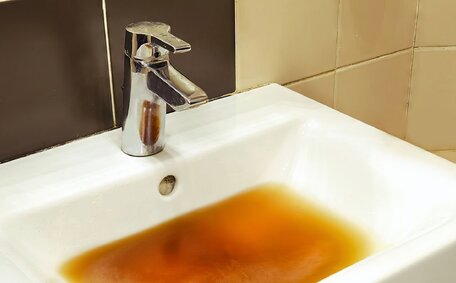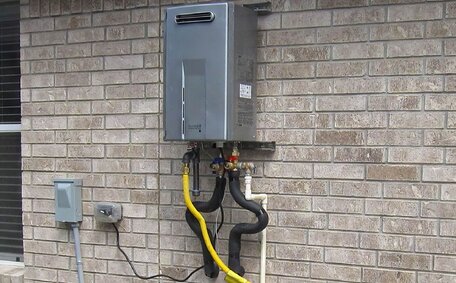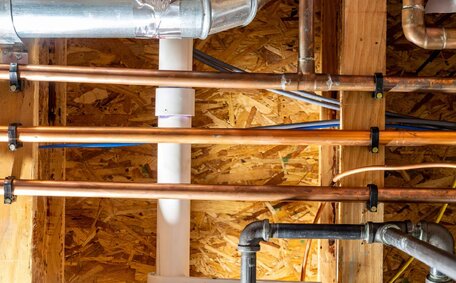Introduction to Flushing a Hot Water System
Regularly flushing your water heater is crucial maintenance to ensure efficient operation and prolong its lifespan. As licensed plumbers based in Vaucluse, Sydney, we’re proficient in guiding homeowners through the process of flushing their hot water systems, and we provide a full range of residential and commercial plumbing services.
We’ll guide you through the steps to flush your hot water tank, crucial for maintaining both electric and gas hot water systems effectively. This involves carefully draining the hot water tank of sediment, an off water task, to maximise heating performance in electric water systems and prevent potential damage over time.
Follow our recommendations for draining your water heater to keep your hot water system in peak condition. If in doubt about any part of the process, don’t hesitate to call us for assistance.
When to Flush Your System and How Often
Experts advise flushing your hot water system yearly, or more often as necessary, to prevent sediment buildup. Those with hard water may need drain flushing more often, such as every 3-6 months. More frequent hot water usage can also increase sediment accumulation.
Flushing annually is critical preventative maintenance for your system’s efficient operation. Sediment accumulation can reduce heating efficiency, increase energy usage, and damage your water heater’s core components.
Watch for any decrease in hot water flow, listen for rumbling noises from the tank, and check if your thermostat struggles to maintain the temperature. These signs may indicate sediment buildup, suggesting a need for flushing ahead of your next scheduled maintenance.
For optimal performance and to extend the life of your hot water system, adhere to a routine flushing schedule. Contact our team if you are unsure about the timing for your flush hot water system maintenance.
Identifying Signs Your System Needs Flushing
Recognise key signs that signal your water heater requires flushing:
- Discoloured water - Rusty, brown, or dirty-looking water may indicate sediment accumulation and mineral deposit formation inside the tank.
- Noisy operation - If you hear rumbling, cracking, or banging noises coming from the hot water system, there is likely sediment accumulation.
- Pressure loss - Reduced water flow from hot taps can mean sediment is obstructing pipes connected to the water heater.
- Overheating - Sediment buildup reduces heating system efficiency, causing the unit to work harder to heat water, potentially overheating.
Proactively flushing your water heater, ideally annually, helps to prevent these issues. Should you observe any of these symptoms before the next maintenance, contact us for a licensed plumber to flush your hot water system.
Safety Precautions Before Flushing
Before you turn off and drain your hot water system, it’s important to take several safety precautions:
- Ensure you turn off the power supply to your electric hot water system at the switchboard by flipping out your circuit breaker and turn gas off to your gas hot water system as well. Close the cold water valve and turn off the gas at the isolation valve for safety.
- Relieve the pressure and control the water coming out of your tank by carefully opening the pressure relief valve. Position a bucket underneath to collect the water efficiently as it is released.
- Keep a garden hose ready to drain water effectively when you open the drain valve at the tank’s base. Ensure the other end of the hose lies in an area where the drainage can safely manage the water as it begins to cool down outside your home.
- Clear items away from around the hot water unit and place buckets underneath to catch flushed water.
- Ensure you have protective equipment like gloves and safety goggles at the ready.
Once you’ve disabled electrical and gas supplies, relieved tank pressure, and attached the drain hose, you’re ready to start draining and flushing your hot water tank. Never commence draining if the power/gas has not been turned off, as a cautionary measure.
If unsure about any precautions, call our team for guidance before flushing your hot water system.
Tools and Materials Needed
Flushing your hot water system will require having the following tools and materials on hand:
- Garden hose - At least 10 metres long, to attach to the drain valve and reach an outside area for drainage
- Adjustable wrench or pliers - To loosen connections for the drain hose
- Buckets - Several clean buckets to catch drained water
- Old towels or rags - To wipe up any spilled water
- Gloves - Preferably rubber, for protection
- Protective eyewear - Such as goggles, to shield against splashing water
- Flashlight - For improved visibility inside darker areas around the tank
- pH test strips (optional) - For testing leftover sediment acidity after draining
Assemble all necessary equipment before you begin. Avoid makeshift substitutions for key tools noted above. And check that your garden hose has no leaks or blockages.
With the proper gear ready, you can safely and effectively drain tank sediment during a flush of your hot water system. If lacking any recommended items, call our team to inquire about rental options.
Step-by-Step Guide to Flushing
Here’s one more outline of the key steps to ensure you properly flush your water system:
- To turn off water heating, disable the electricity or gas supply, then turn hot water flow off and open a hot tap to relieve pressure in the tank.
- Attach a garden hose to the water tank’s drain valve at the bottom of your tank to facilitate the flow and drain your system outside.
- Position buckets beneath to catch water, adorn protective gear, and let tank drain valve open with the use of adjustable pliers.
- Drain the tank completely, using a flashlight to check for sediment. Anticipate the drainage opening up as around 100 litres empty out.
- After draining, detach the hose from the drain valve and close any additional inlets to prevent unexpected water discharge from your tank.
- Connect the hose to the cold water inlet valve then feed into tank for flushing and replenishing.
- Run tap water through for 5 minutes, then turn it off and close the drain valve.
- Inspect the heater tank interior with a flashlight to ensure sediment removal before refilling the system.
Take care when handling drained fluids. Refer to manufacturer guidelines for further system restarting and refilling instructions. Call our team if you have any uncertainties about properly flushing your hot water heater.
For Gas Systems
Flushing gas hot water systems comes with a few extra precautions compared to electric models.
The key difference when draining a gas heater is ensuring the manual gas control valve is turned fully off. Additionally, you must extinguish the pilot light to fully drain your heater, typically by gently turning the control knob at the burner chamber’s base.
With the gas off and pilot light out, follow the same process: attach the drain hose and remove the sediment.
Check the interior of a gas water heater cautiously after draining to prevent residual gas hazards. Ensure adequate ventilation of the area before attempting to relight the pilot light or restoring the gas supply.
Refer to the manufacturer’s guidelines for proper procedures to restart your specific gas hot water system after flushing. And as always, call our team if unsure about any aspect of draining a gas heater safely.
For Electric Systems
Flushing an electric hot water system requires additional steps distinct from those for gas heaters.
The most important precaution with an electric unit is turning off power at the main circuit breaker before draining the tank. This disables the heating elements to prevent potential electric shock or damage while working on the system.
After draining the tank, thoroughly inspect the heating elements to ensure they are intact and uncorroded before the flush. Also check electrical wiring is secure and shows no damage before refilling.
Follow all other flushing steps as normal in terms of attaching the drain hose and rinsing sediment from the tank.
Consult your electric heater’s manual for the correct rebooting procedures following a flush. Do not restore power to the heater until the tank is confirmed to be fully refilled. Call our team if you have any questions about flushing your electric hot water system safely.
For Tankless Systems
Flushing storage hot water systems requires precise adherence to a tried-and-true process differing from the approach used for tankless varieties.
Start by turning off the power supply and gas valve (for gas systems). Then locate the unit’s drain valve and attach a garden hose to empty out any sediment.
You may need to pump water to ensure strong enough water flow for flushing. Descale the internal pipes using a descaling solution or white vinegar. Circulate flushing water through the system for 15-20 minutes before draining.
Finish by completely rinsing the tankless unit with clean water into to remove any solution residue. Check manufacturer guidelines for proper restarting procedures once finished.
Tankless heaters need flushing less often than storage tanks, but annual descaling helps keep them operating efficiently. Contact our team if you need assistance servicing your tankless hot water system.
Flushing to Remove Sediment Buildup
Mineral deposits can cause sediment to gather at the bottom of your hot water tank over time. Flushing helps remove this sediment buildup by draining all water and flushing clean water through.
Removing sediment buildup is crucial because it:
- Enhances heating efficiency - Sediment hinders heat transfer by insulating heating elements.
- Prolongs appliance lifespan - Corrosive sediment damages components like heating elements.
- Restores water flow - Sediment obstructs pipes connected to the water heater.
Allowing sediment accumulation in water tanks reduces system performance and can eventually lead to complete appliance failure. Regular flushing of your hot water system helps prevent sediment damage, even if symptoms have not yet appeared.
Our detailed guidance helps homeowners understand how do flush their systems as essential preventative maintenance themselves. Alternatively, call our team if you need a licenced Sydney plumber to handle flushing your hot water system.
Refilling and Restarting Your System
Having flushed your hot water system and conducted an inspection, here are the steps to safely refill and restart your tank:
- Securely close the drain valve, typically a ball valve, after you’ve assured that all sediment is flushed from the bottom of the tank.
- Reconnect the garden hose to a tap, turn the cold water off, and feed the hose back into the tank.
- Slowly turn on the cold water supply to let water flow into system from the tank inlet valve to completely refill the tank. Expect this to take around 30-40 minutes.
- Once filled, turn the cold water off and disconnect the hose from the drain valve.
- For electric systems, you’ll have to locate the main water valve and ensure it’s turned off before resetting the power at the circuit breaker. For gas systems, turn off gas supply, and then reignite the pilot light.
- Open a hot water faucet and let it run until water runs without air bubbles, which activate the heating elements. Let water run until flowing clear.
- Visually inspect your water heater tank for leaks from valves/fittings and check if the system pressure gauge reads correctly before returning the unit to regular use.
Refer to your specific water heater’s manual for further advice on restarting and refilling to flush hot water system, and don’t hesitate to call us if you encounter any issues. And call our team if you have any issues getting your hot water system safely up and running again after flushing.
Maintaining Efficiency Post-Flush
Flushing your hot water system removes sediment buildup and restores heating efficiency, but you’ll need to undertake ongoing maintenance for continued optimal performance.
Key tips for maintaining efficiency after flushing include, ensuring you don’t end up with residual sediment:
- Inspect anode rods annually – These corrode over time to protect tank integrity. Replacements may be needed to prolong tank life.
- Annually verify insulation around the tank, replacing any sections you can see have deteriorated.
- Follow manufacturer guidelines for any other required servicing tasks.
- Investigate and address minor leaks immediately to prevent wasting heated water.
- Consider upgrading to a higher efficiency system when age or condition warrant replacement.
Keep to a regular tank flushing schedule, alongside other water your maintenance. This practice offers the greatest assurance of energy efficiency, safety, and your hot water system’s longevity.
Contact our team for a licenced Sydney plumber to manage all aspects of hot water system maintenance, including flushing and full replacement.
When to Call a Professional
While flushing a hot water system is often a straightforward DIY task, there are times when it’s best to call in a professional plumber for assistance:
- If your system needs specialized equipment or chemicals, like descaling solutions for tankless models.
- If you cannot access or disconnect components of the system yourself to perform flushing.
- If any issues or malfunctions occur during the flushing process that you are unable to troubleshoot.
- For older or complex systems, having an expert service technician complete flushing is advisable.
- To inspect and certify that your system is properly flushed, functioning safely and ready to be put back into regular use.
Our team, as licensed plumbers in Vaucluse, Sydney, has extensive experience servicing various residential and commercial hot water systems.
For complete peace of mind that your system flushing is conducted safely and correctly, call us on 1300 349 338 or email [email protected] to have one of our qualified technicians flush your hot water system.






